All types of dogs belong to the same species — Canis lupus familiaris.
But they have been categorized into 7 different dog groups by the AKC and The Kennel Club.
The classification of purebred dogs in both the Kennel Clubs is according to the specific jobs or uses they were originally bred for.
Even the show dogs exhibited at the AKC National Championship and the Crufts belong to the 7 dog groups.
As of 2021, the Kennel Club has categorized 222 breeds of dogs.
Keeping up with them The AKC also has 450 different types of dogs, organized into the 7 dog breed groups.
Knowing a dog’s breed by its roots will help you provide the best care based on their breed’s precise needs.
Have you ever wondered why sometimes a Border Collie who has never seen a farm animal, tries to herd them and other human kids around him?
“You can take the dog out of its instinctive environment but, you can’t get the instincts out of the dog”.
This article will be your A-Z guide about the 7 dog groups.
More importantly why all the different dog breeds have been categorized into these dog groups.
Fun Fact
The AKC has been criticized for the prevalence ofgenetic disorders in their dogs. As many as 25% of purebred dogs registered by the AKC has at least one hereditary genetic problem.
Table of Contents
What Are Groups of Dogs Called?
Dogs were put into different types of groups.
These groups are based on the dog’s characteristics and the reason they were originally bred for.
According to the roles they were originally bred for, dogs were divided into 7 dog groups by the AKC which were —
Working Dogs
Hound Dogs
Toy Dogs
Terrier Dogs
Sporting Dogs
Non-Sporting Dogs
Herding Dogs
The UK Kennel Club being the creator of the Kennel Clubs, categorized the dog groups differently.
Although they resembled the AKC Dog Groups, they had different name tags which were–
Working Dogs
Hound Dogs
Toy dogs
Terrier Dogs
Gun Dogs
Utility Dogs
Pastoral Dogs
There is also a Miscellaneous Group of Dogs; the ones that do not fit any of the above dog groups.
What are the 7 Major Dog Groups?
450 types of dogs have been categorized into 7 dog groups by the AKC:
Working Dogs
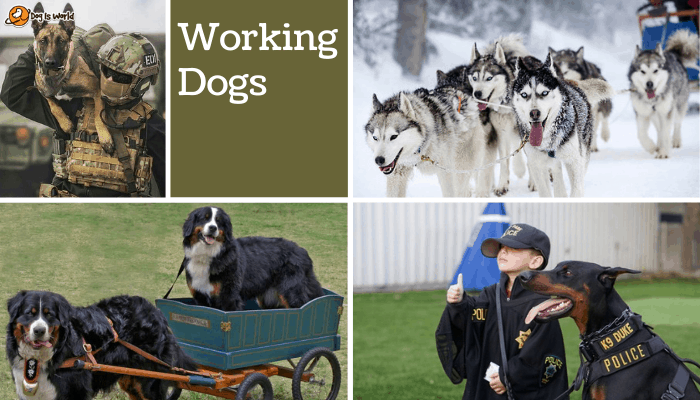
All types of dogs in this dog group were originally bred to assist mankind in some capacity.
They were used to perform tasks like pulling sleds and carts, guarding livestock and homes, and even protecting the families.
These working dog breeds have been proven to be invaluable to humans throughout the ages.
Working dog group breeds were bred to be hunters, guard dogs, or even “Draft Dogs” in some places.
Dogs in the working group are the blue-collar workers of the dog world. This group in fact has some of the world’s most ancient breeds.
These medium to large dogs are very intelligent, loyal, strong, athletic, and are well known for their courage.
People pleasers, if you can give these powerfully built animals a job to do, they’ll make great enthusiastic companions for years to come.
Their considerable size and strength alone make them unsuitable pets.
Considering their size alone, they have to be trained properly.
In today’s time, you can find these mighty heroes serving as police dogs, military dogs, security dogs, guide dogs, and even hunters.
Dogs in the working group include
Alaskan Malamute
Siberian Husky
Great Dane
Doberman Pinscher
Rottweiler
Akita
Neapolitan Mastiff
Bernese Mountain Dog
Saint Bernard
Hound Dogs
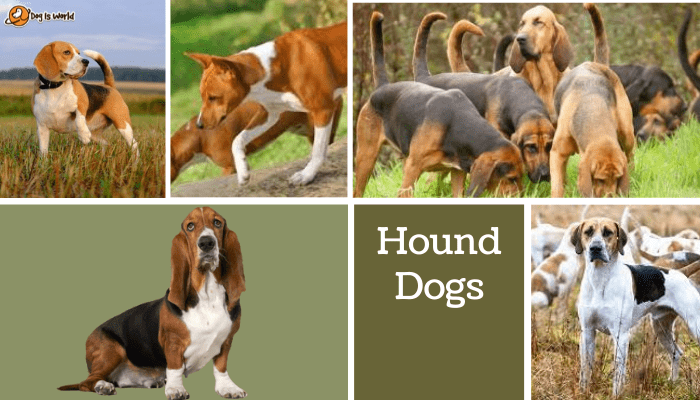
Dogs in the Hound Group were originally categorized as Sporting dogs because of their use in hunting.
Breeds in this group vary in size, shape, and coat.
Hound dogs have strong prey drives and were bred to chase warm-blooded quarry. They stopped at nothing until they caught their game.
Most hound dog breeds share a common ancestral trait — hunting.
Many of them were raised to hunt independently and chase their prey without their owners, who would usually follow them on foot or horseback.
Generalizing dogs in the hound group is difficult, as it has many different types of dogs classified into 2 subgroups: sighthounds and scent hounds.
Sighthounds use their phenomenal gift of stamina and wise vision to chase swift prey.
Scent hounds use their precise scenting powers and rely on their noses to track anything, from game to escaped convicts.
Today only a few dogs in the hound group are used for hunting purposes, their hunting instincts remain strong throughout their dog group.
They are affectionate and strong-willed pups have a distinct ability to produce a unique sound known as baying.
Due to their powerful sense of smell, the hound dog group make ideal applicants for law enforcement.
Dogs in the Hound Group include
Basset Hound
Beagle
Harrier
American Foxhound
Dachshund
Saluki
Greyhound
Afghan Hound
Bloodhound
Toy Dogs
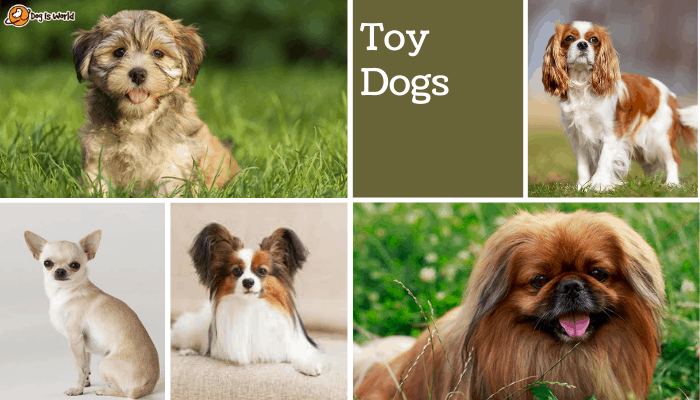
Dogs in the Toy Group make the perfect lap dogs.
They are small in size but have big brains.
They have big personalities stored in a small package. Big enough to even dominate dogs 10x times their size and sometimes even people.
The “toy” term in their dog group is mainly just for the description of their size.
Some toy dogs have been bred down from larger breeds and some of them even retain their inherited instincts.
Others ruled the dog group as prized lapdogs and royal companions.
Their small dog size and adorable expressive faces show us the basic function of this group: to personify sheer happiness.
All kinds of dogs in the toy group in a way play their parts as working dogs.
Working hard to be cute, attentive, and affectionate puppers.
Toy dog breeds are a blessing for the city-dwellers, they are ideal apartment dogs (thanks to their size and portability).
Despite their tiny stature — they are tough as nails and vocal enough to make it to the watchdog list.
The toy dog group primarily consists of small and very small dog breeds weighing between 8lbs to 11lbs.
Dogs in Toy Group include
Pekingese
Chihuahua
Pomeranian
Maltese
Cavalier King Charles Spaniel
Bichon Frise
Shih Tzu
Papillon
Pug
Terrier Dogs
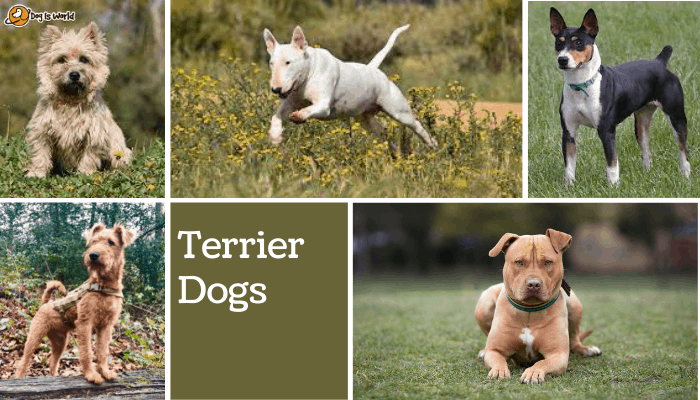
Terrier dogs were originally bred to kill vermin.
Today they have become adored pets and great watchdogs.
All terrier dog breeds evolved from the British Isles except for two.
The geographical regions helped determine the duties of each dog breed which primarily involve hunting vermin and varmints.
They typically have a low tolerance for small animals and are not so great with kids.
Suggestion: 15 Best Dogs for Kids
People who know this dog group consistently talk about these dogs having a very distinctive feisty and mischievous personality.
There are two subgroups in the terrier group — the short-legged terriers and the long-legged terriers.
The short-legged feisty breeds were bred to burrow in pursuit of the vermin and rodents.
Their determination, courage, and self-confidence have no match when they have their game faces on.
Whereas the long-legged terrier dogs dug out the varmint.
Meanwhile, the group’s “bully” breeds, which were developed for blood sports like bull-baiting, are popular pets today.
Ancestors of the terrier group of dogs were bred to kill vermin, their eager personality is always up for a spirited argument.
This group of dogs is an excellent competitor in the sport of Earthdog.
Dogs in the Terrier Group include
Airedale Terrier
Rat Terrier
Jack Russell Terrier
Fox Terrier
West Highland White Terrier
Australian Terrier
Border Terrier
American Staffordshire Terrier
Scottish Terrier
Sporting Dogs
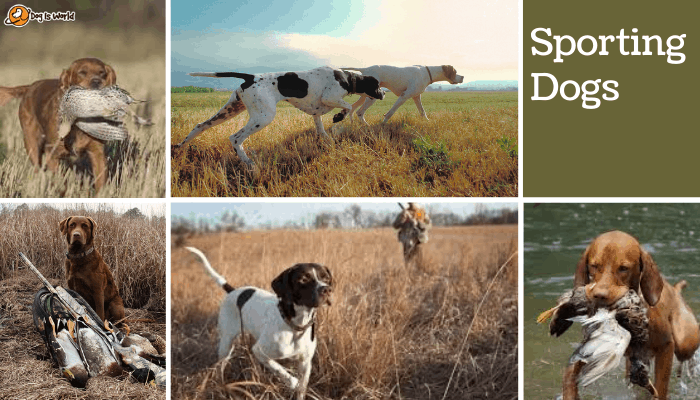
Sporting dogs were bred to help hunters in capturing and retrieving their game since the 1600s.
This category of dogs includes pointers, retrievers, setters, and spaniels, some still fulfill the tasks for which they were bred.
Following the introduction of the rifle, sporting, or gun dogs were developed.
They majorly assisted in the hunting of upland game birds or ducks under the instruction of the hunter.
Many dog breeds in this group have thick, water-repellent coats that allow them to survive in severe hunting situations.
Pointers and setters are primarily responsible for pointing and marking game, Spaniels are responsible for flushing game, and Retrievers are responsible for recovering dead and wounded game.
These have been trained to help hunters in finding, pointing, flushing, holding, and retrieving game.
This group of dogs aren’t just limited to hunting, they even excel as companion dogs, therapy dogs, search and rescue dogs, even assistance dogs.
Sporting dog breeds are likable, well-rounded companions because they are naturally active and alert.
They’re athletic and active, with a kind demeanor and a can-do mentality.
A would-be owner needs to keep in mind that this dog group requires invigorating exercise to keep them occupied.
The high-energy dogs in this pack have a strong desire to be outside.
They have become one of the most popular dog breeds for families due to their undying loyalty and outstanding trainability.
Many of these breeds are known for their instincts in the water and forests, and many of them still participate in hunting and other field sports.
Retrievers, which are developed for swimming, specialize in ducks, while setters, spaniels, other pointing breeds hunt in the grasslands where the game birds nest.
Dogs in the Sporting Dog Group include
English Cocker Spaniel
Irish Setter
Labrador Retriever
Chesapeake Bay Retriever
English Springer Spaniel
German Shorthaired Pointer
German Wirehaired Pointer
Clumber Spaniel
American Water Spaniel
Non-Sporting Dogs
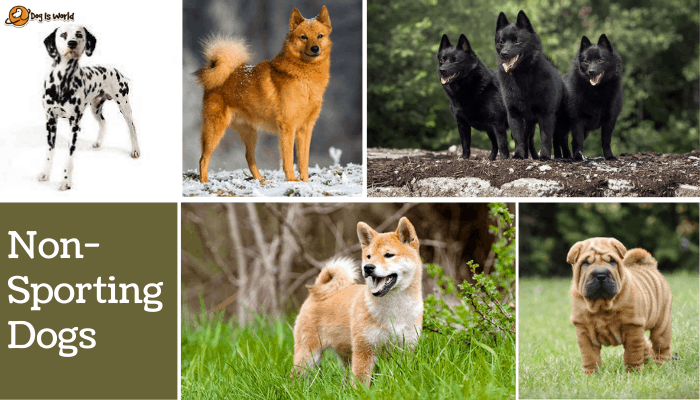
Dogs were formerly classified as either Sporting or Non-Sporting by the AKC.
Toys and Working dogs were eventually separated from non-Sporting.
The Herding Group was eventually separated from Working.
The Non-Sporting Group now encompasses every remaining breed, resulting in a vast range of sizes, forms, hair types, functions, and histories.
Today this group is home to those different dog breeds who no longer perform the duties they were originally bred to carry out.
For example, Dalmatians don’t accompany horse-drawn carriages anymore.
Non-Sporting Dog Group has a variety of breeds, but they all have two things in common: wet noses and four legs.
After that, there isn’t much in common with this mishmash of breeds whose job descriptions defy categorization in the other six groups, even though they all have fascinating backstories.
Today, the Non-Sporting Group’s various breeds are primarily sought after as companions.
The Chow-Chow, Dalmatian, French Bulldog, and Keeshond are all tough dogs with distinct personalities and features.
What a contrast in size, coat, and mien!
Some, such as the Schipperke and Tibetan Spaniel, are unusual to see in a typical neighborhood.
Others, such as the Poodle and the Lhasa Apso, have a sizable following.
The Non-Sporting Group is an unusual dog group.
In that, it does not categorize dogs based on their purpose or size; instead, it serves as a go-to-gang for dogs who don’t fit into other categories.
As a result, this group of dogs has a wide range of physical and personality characteristics, but they are all runners-up for a loving pet.
Dogs in the Non-Sporting Group include
Dalmatian
Schipperke
Finnish Spitz
American Eskimo Dog
Boston Terrier
Shiba Inu
French Bulldog
Chow-Chow
American Bulldog
Herding Dogs

The Herding Group is the newest AKC classification, having been established in 1983. Its members were previously members of the Working Group.
Herding dogs work closely with their human shepherds and are extremely trainable due to their natural intelligence and attentiveness.
They are the easiest to train among all the different dog breeds, making them ideal for dog obedience training, herding trials, and agility sports.
Herding dogs have been bred to be smart, athletic, and hardworking.
They possess magnitudes of capacity to herd other animals like sheep, cattle, and even reindeer breeds.
Their zest to regulate the movement of other animals is shared by all breeds.
For example, the low-set Corgi who is only a foot tall can drive cattle.
This dog group has high levels of energy but majorly being household pets, they have never come across any farm animals.
Finding them a job is a must or else you find them gently trying to herd other pets and even children.
The Herding Group has matured into independent but loyal canines who are happiest when they are serving their dog owners.
These dogs are great, loving pets who thrive on—and demand—human connection when given enough exercise and mental stimulation.
Some herding breeds, such as the German Shepherd Dog, are now extensively used in law enforcement.
What dogs are in the herding group?
Dogs in the Herding Group include
Australian Shepherd
Border Collie
Shetland Sheepdog
Pembroke Welsh Corgi
Canaan Dog
Australian Cattle Dog
Belgian Tervuren
Cardigan Welsh Corgi
German Shepherd
This Concludes the 7 Major Dog Groups that AKC has categorized all kinds of dogs into.
These dog groups are categorized for the AKC dog show.
Similarly, The UK Kennel Club has its own 7 major types of dog groups.
All have similar characteristics to that of the AKC groups but some have a different set of names.
Even though both Kennel Clubs have 4 similar dog groups that are –
Working Dogs
Terrier Dogs
Hound dogs
Toy Dogs
The UK Kennel Club has 3 groups with different names but the same characteristics-
Gun Dogs
Utility Dogs
Pastoral Dogs
Gun Dogs
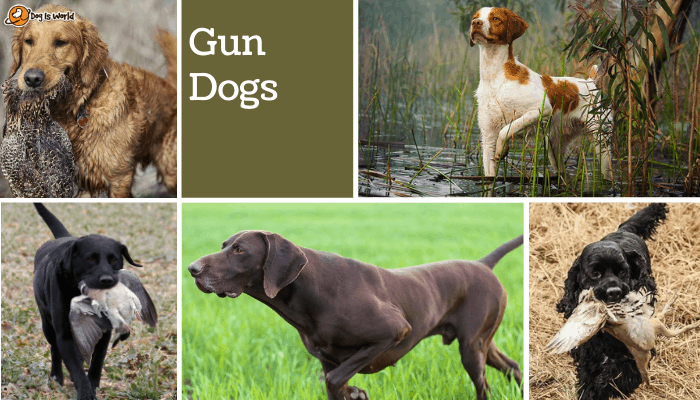
Similar to the AKC’s Sporting Dogs – Gun dogs were originally bred to help their owners hunt game.
Sometimes known as bird dogs these hunting canines have been bred to aid hunters in locating and retrieving game, most commonly quail, dove, or duck.
Historically, they were valued for their hunting abilities.
Retrievers, flushing dogs, and pointing breeds are the three main types of gun dogs.
Golden Retrievers, Labrador Retrievers, and Cocker Spaniels are the most frequent types of gun dogs.
This group of dogs is commonly referred to as bird dogs because their primary target is birds, but they also hunt smaller animals like rabbits.
Gundog breeds are frequently described as the ideal family pet.
Originally designed to assist their owners in hunting game, they are now dependable and affectionate companions who will readily seek trouble if bored or lacking inactivity.
When a bird is shot, the dog should mark the spot where it fell and wait to recover it until the command is issued.
The dog will sprint to the site of fall, pick up the bird, and return it to the handler once commanded.
Dogs in the Gun Dog Group include
English Setter
Pointer
Portuguese Pointer
Golden Retriever
Labrador Retriever
American Cocker Spaniel
Cocker Spaniel
English Springer Spaniel
Weimaraner
Utility Dogs

Similar to the AKC’s Non-Sporting Dogs these dogs were once bred for a variety of reasons.
As a result, this dog breed group is quite diverse, with breeds ranging from Akita to Bulldog, Chow-Chow to Dalmatian, each created to fulfill a specific requirement.
Utility dogs are a diverse group of breeds that are primarily non-sporting in origin and were bred to do specific tasks in the past.
What are Utility Dogs?
Utility dogs are a diverse group of breeds that are primarily non-sporting in origin and were bred to do specific tasks in the past.
This is the category for all the breeds that don’t belong anywhere else!
Most utility dogs were bred to be useful and valuable to our lives, as their name suggests.
Typically, they are ‘ultra-specialists’ who have been trained to work in a very specialized geographical location, scenario, or vocation.
Poodles, Bulldogs, and Shih Tzus are breeds that we all know and adore, and they all show how diverse this group is out of all the dog groups.
This group includes some of the world’s oldest documented breeds with working or non-sporting dogs’ origins.
As a result, no dog has particular breed features.
Therefore, owners must look into the dog’s characteristics by breed to determine how the dog will interact with them.
Utility dog breeds can be found working beside fire engines and noble carriages, enticing ducks, companions, fighting and serving as a warning system for barge owners or monks,
Utility dog breeds include dogs with jobs as diverse as running alongside fire engines and the carriages of noblemen.
Even attracting ducks, an early warning system for barge owners and monks, companions, and fighting.
Dogs in the Utility Dog Group include
Boston Terrier
Bulldog
Chow-Chow
Dalmatian
French Bulldog
Lhasa Apso
Standard Poodle
Schnauzer
Shih Tzu
Pastoral Dogs
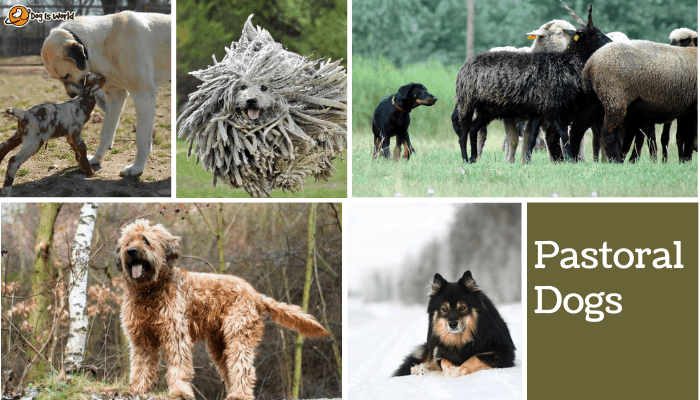
Similar to AKC’s Herding Dog Breeds, the Pastoral Dogs were bred to work with grazing animals.
Pastoral dog types exist in a variety of sizes and forms, they all love having a job to do.
Pastoral dog breeds enjoy collaborating with their owners and will wag their tails anytime the entire family participates in training, exercise, or playtime.
Examples of Pastoral Dogs that were developed to help control sheep or cattle were Sheepdogs, Collies, and Corgis.
Given their experience in moving and guarding animals, it’s no surprise that pastoral dogs may readily become dependable family members.
Not that it is a surprise but they are always willing to cooperate while still demanding a lot of activity.
Dogs in the Pastoral Dog Group include
Australian Cattle Dog
Border Collie
Smooth Collie
Polish Lowland Sheepdog
Shetland Sheepdog
Swedish Vallhund
Turkish Kangal Dog
Cardigan Welsh Corgi
Pembroke Welsh Corgi
We have managed to scour the internet high and low to get you the answer for which dog groups do all types of dogs belong to, at your fingertips.
The AKC also has a Miscellaneous Dog Group, one that includes the breeds of dogs that haven’t been classified or recognized.
Frequently Asked Questions
Corgis and Collies belong to the Herding Dog Group Under the AKC and Pastoral Dog Group under The UK Kennel Club.
Yes, Terriers are Hunting Dogs. They belong to the Terrier Dog Group categorized by The AKC and The UK Kennel Club.
In 2021, The AKC has 360 registered breeds of dogs. The Kennel Club has 223 registered breeds of dogs.
And the FCI has a fluctuating number between 390-400 types of dogs.
There are only 7 dog groups recognized by The AKC and The UK Kennel Club.
The 8th group is not a legitimate dog group but is considered as the Miscellaneous or the Hybrid Dog Group, which consists of dogs that have not been recognized or classified by the Kennel Clubs yet.
The FCI (Federation Cynologique Internationale) has 10 Recognized Dog Groups under its administration, namely - Sheepdogs & Cattledogs, Pinschers & Schnauzers, Terriers, Dachshunds, Spitz & Primitive Types, Scent Hounds & Related Breeds, Pointing Dogs, Retrievers-Flushing Dogs & Water Dogs, Companion & Toy Dogs, and Sighthounds.
Aloha Readers,
We hope you enjoyed reading our article and that you have found the answers regarding dog groups that you have been looking for.
Do let us know if we have missed out on any details in the comment section below.
If you found this article helpful, do share this article with anyone as curious about the dog groups as you were.
Happy Petting to You Guys!












